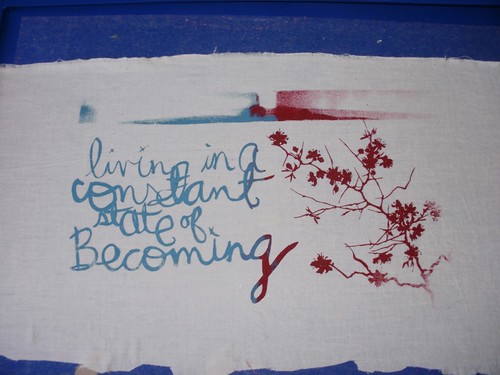Over the holidays, I was lucky enough to get a Yudu screenprinter.
Score!
After seeing a demonstration, I just knew I had to play with one myself. How can you not want to? You can take artwork, photos -- just about anything -- and transfer it to fabric, bags, journals.... Just imagine me with a dreamy sigh just about now.
Before starting, I did the following:
+ read the quick start guide. twice.
+ watched the demo videos on the website.
+ consulted yuduforums.com
The demo videos make it LOOK incredibly easy, but I will tell you this:
You WILL mess up your first screen. You will PROBABLY mess up your second.
Applying the Emulsion
Sorry, guys, but this is the truth. It is NOT easy to apply the emulsion sheets to the screen. Not at all. You will need more water than you think. But there’s a delicate balance and unfortunately, the only way you’ll learn the perfect amount is by experimenting. For this reason, I suggest you cut the emulsion sheet that comes with the Yudu in half or even quarters to practice. Those suckers are expensive, so you want to get as much out of the one in the box as you can before shelling out the $20 for two new ones.
Next, you’re going to need help. While one demo video shows a person doing this all on their own, the one on the DVD shows two people. When you’re starting out, grab someone else to work with you. At least you’ll have someone to laugh with when things don’t work out according to plan.
Out of everything, everything that you do with this system, the hardest is applying the emulsion sheet to your screen. If you don’t get it wet enough, it won’t stick to the screen and you’ll have huge holes. If you get it too wet, it’ll get all liquid-y and too thin and when you go to wash it after burning an image, you’ll get holes.
Maybe I should just say it that way: you will get holes. Not in the screen, just the emulsion.
You see, the way this works is this: when you dry the emulsion, it forms a shell on the screen that doesn’t allow any paint to get through onto your item. By “burning an image” you’re breaking through this shell where you want in order to create a design. So making sure you use the right amount of water really influences how well your screenprint image will transfer onto whatever you’re printing onto.
I tried a sponge at first and, well, that didn’t go so well. Firstly, it didn’t put nearly enough water on the screen. Second, when I added more water, it smeared the emulsion. We tried anyway, going through the whole process of applying it and drying the screen.
The best method we’ve found is using a spray bottle and sponge. Here are the steps we follow:
1. Run the screen under your sink.
2. Pat it so it doesn’t drip all over your floors but not so much as to remove much water.
3. Hold it up to a light source or window. You should be able to see the difference between holes filled with water and those without. You want all the holes to be filled with water.
4. Apply the emulsion sheet and use the squeegie a few times to evenly apply it.
5. Turn the screen over. There, you also will see a difference between where the sheet has stuck and where it hasn’t. Carefully spritz some more water here and there and pad with the sponge. (It helps to have another person with this step; have them put their hand directly on the screen under the not-quite-done parts to give you a solid surface to pad onto with the sponge.)
Do NOT make ANY strokes with the sponge! This will cause the emulsion to move around, too! Pad GENTLY with the sponge -- don’t let any extra water bubble up!
6. Place the screen shiny side DOWN into the dryer. You’ve probably got some too-wet areas, and drying it this way will keep those areas pooled instead of dripping around.
The instructions say dry it for ONE cycle in the drying rack. PLEASE do it for THREE.
If you try to pull off the “shiny” side after one cycle, you will pull off emulsion, and we don’t want that. Please please put it in for THREE cycles. That’s an hour. More than enough time to create an image to burn.

